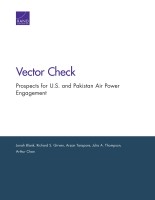| 来源类型 | Research Reports
|
| 规范类型 | 报告
|
| DOI | https://doi.org/10.7249/RR2107
|
| ISBN | 9780833099358
|
| 来源ID | RR-2107-AF
|
| Vector Check: Prospects for U.S. and Pakistan Air Power Engagement |
| Jonah Blank; Richard S. Girven; Arzan Tarapore; Julia A. Thompson; Arthur Chan
|
| 发表日期 | 2018
|
| 出版年 | 2018
|
| 页码 | 128
|
| 语种 | 英语
|
| 结论 |
Engagement- The U.S. Air Force (USAF) would be wise to maintain a steady level of engagement with Pakistan Air Force (PAF), rather than trying to scramble for a rapid engagement when the next cycle begins. The USAF should prepare for the next cycle — now. This can and should be done in a manner which does not jeopardize the growing security engagement between the United States and India. But if past is prologue to the future, there will likely be another such turn of the wheel with Pakistan, and it may well arrive (as it has the past two times) quite literally overnight.
Future Trends- The USAF should understand and accept its role as "loss leader" of U.S.-Pakistan relations. The USAF should not expect its relationship with PAF to be one of institutional parity: PAF has less to offer the USAF than vice versa, while the benefits provided by Pakistan (human intelligence for counterterrorism, facilitation of Taliban reconciliation, nonproliferation cooperation, and policy guarantees of regional stability) will accrue to other parts of the U.S. security establishment.
|
| 摘要 |
- The U.S. Air Force (USAF) should prepare now for the next cycle of overnight engagement.
- The USAF should recognize that it has been, and is likely to be in the future, the "loss leader" of U.S.-Pakistan relations.
- The USAF and U.S. policymakers should understand the limits of U.S., and particularly USAF, leverage over Pakistan's choices.
- The USAF and U.S. interlocutors should calibrate Pakistan's expectations about what is politically feasible in the United States. They should also recognize the impact of the tone of rhetoric by members of the U.S. policy community.
- Subject always to changing geopolitical circumstances, the United States should continue to approve maintenance, training, and support for existing Pakistan Air Force (PAF) F-16s, and be wary of calls to forgo (or accelerate) future transfers.
- In cooperation with the Office of the Defense Representative Pakistan, the USAF should request an increase in nonlethal Pakistan-focused International Education and Training for PAF students.
- The USAF should offer the opportunity for PAF to send a select officer to serve as an instructor at a USAF school.
- The USAF should focus USAF-PAF exercises and training on existing technical capabilities, especially those that support or enable humanitarian aid/disaster relief capabilities.
- The United States should — to the extent possible without jeopardizing its relationship with India — consider sales of technical systems that support improved collaboration in areas of shared interests, such as counterterrorism or counterinsurgency missions.
- The USAF should discuss the possibility of sharing service lessons learned and best practices through subject-matter expert exchanges.
|
| 主题 | Afghanistan
; Air Defense
; Fighter Aircraft
; Pakistan
; Security Cooperation
; United States Air Force
|
| URL | https://www.rand.org/pubs/research_reports/RR2107.html
|
| 来源智库 | RAND Corporation (United States)
|
| 引用统计 |
|
| 资源类型 | 智库出版物
|
| 条目标识符 | http://119.78.100.153/handle/2XGU8XDN/108739
|
推荐引用方式
GB/T 7714 |
Jonah Blank,Richard S. Girven,Arzan Tarapore,et al. Vector Check: Prospects for U.S. and Pakistan Air Power Engagement. 2018.
|
|
文件名:
|
x1522239218679.jpg
|
|
格式:
|
JPEG
|

|
文件名:
|
RAND_RR2107.pdf
|
|
格式:
|
Adobe PDF
|
除非特别说明,本系统中所有内容都受版权保护,并保留所有权利。